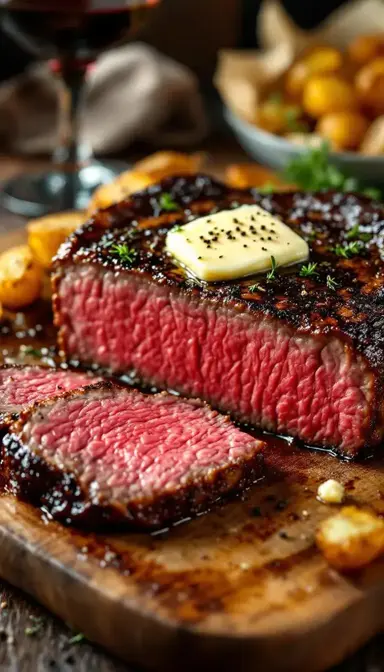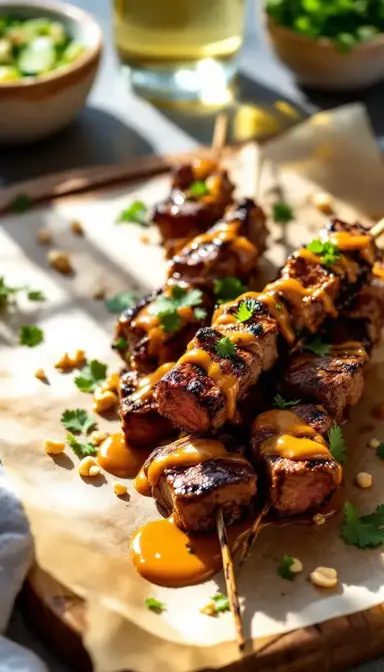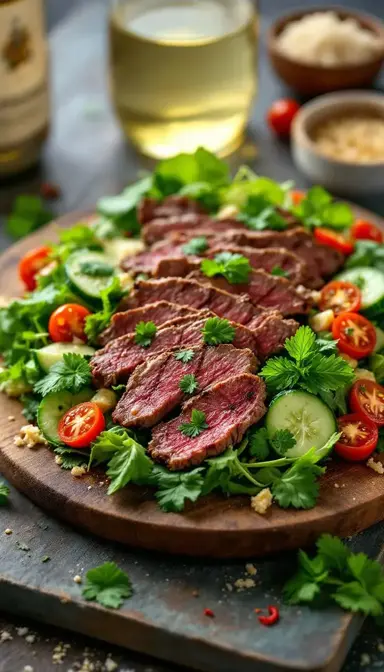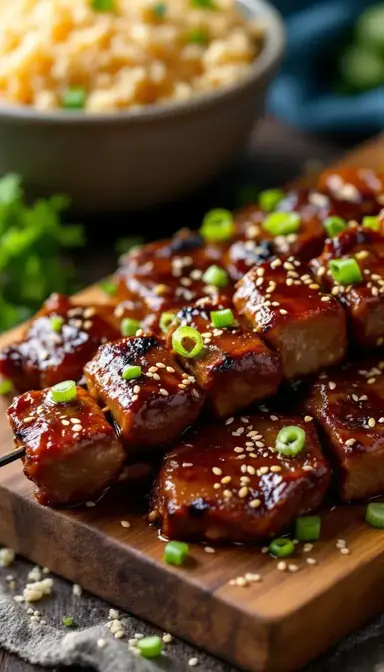Let me tell you about the first time I truly fell in love with a rib-eye. It was a chilly evening, the kind where the kitchen windows fog up from the heat of the stove, and the scent of searing beef fills the air like a promise. That first bite—crusty, buttery, with a center so tender it practically melted—was a revelation. This isn’t just steak; it’s a masterpiece waiting to happen in your skillet.
The rib-eye is the rockstar of steaks, with its marbling like little rivers of flavor running through every bite. When treated right, it rewards you with a texture that’s both luxurious and deeply satisfying. And the best part? You don’t need a fancy kitchen or a chef’s hat to pull it off. Just a hot pan, a little patience, and a whole lot of love for good beef.
Why This Recipe Works
- Dry-brining is your secret weapon—it’s like giving the steak a head start on flavor, letting the salt work its magic deep into the meat. The salt draws out moisture, which then reabsorbs, seasoning the steak from within and improving texture.
- A screaming-hot skillet is non-negotiable. That sizzle when the steak hits the pan? That’s the sound of the Maillard reaction, creating complex flavors and a caramelized crust.
- Resting isn’t optional. Think of it as letting the steak catch its breath after a workout—juices redistribute, and every slice is perfection. Cutting too soon releases those precious juices, leaving the steak dry.
The Story Behind the Sauce
- Simplicity wins. Salt, pepper, heat. No fuss, no fancy tricks—just pure, unadulterated beefy goodness.
- Endlessly adaptable. Want to gild the lily with garlic butter or a splash of red wine reduction? Go for it.
- Quick but impressive. In less time than it takes to watch an episode of your favorite show, you’ve got a steak that’ll make you feel like a culinary genius.
Essential Ingredients & Tools
Ingredients for the Steak
- 1 (1.5-inch-thick) rib-eye steak (12–16 oz) – Thickness matters here. Too thin, and you’ll overcook it before the crust forms. Bone-in adds an extra layer of richness, like a bonus flavor packet hidden inside.
- 1.5 tsp kosher salt – Not just for seasoning—it’s the key to that crave-worthy crust. Table salt can be substituted (use 1 tsp).
- 1 tsp freshly cracked black pepper – Pre-ground pepper is like decaf coffee: why bother?
- 1 tbsp high-smoke-point oil – Avocado or grapeseed oil won’t bail on you when the heat gets intense. Canola oil works in a pinch.
- 2 tbsp unsalted butter – Because everything’s better with butter, especially when it’s foaming with garlic and herbs.
- 2 garlic cloves, smashed – No need to mince; we’re going for big, bold flavor here.
- 2 sprigs fresh thyme or rosemary – These aren’t just garnish—they’re flavor bombs waiting to infuse your steak. Dried herbs can be used (1/2 tsp), but fresh is ideal.
Tools You’ll Need
- Cast-iron skillet – The heavyweight champion of searing. It holds heat like a champ and gives you that restaurant-quality crust. A heavy stainless-steel pan works too.
- Tongs – Use these to flip your steak like a pro—no stabbing allowed. We’re not vampires; we want to keep those juices inside.
- Instant-read thermometer – Guesswork is for carnival games. For perfect doneness every time, trust the numbers. A meat thermometer with a probe is a good backup.
- Wire rack – Lets your steak rest in style, avoiding the dreaded soggy bottom. A plate with raised edges works if you don’t have one.
Serves: 1 (because sharing is overrated) | Prep: 5 mins (plus 1–24 hrs dry-brining) | Cook: 10 mins | Total: 15 mins
How to Make The Ultimate Pan-Seared Rib-Eye Steak
1. Dry-Brine Like a Boss
Grab your 1 (1.5-inch-thick) rib-eye steak (12–16 oz) and pat it dry like you’re tucking it in for the night. Moisture is the enemy of a good sear—it’s the difference between a crust and a steam bath. Season it generously with 1.5 tsp kosher salt on all sides, then let it chill uncovered in the fridge on a wire rack for at least an hour (overnight is even better). This isn’t just salting; it’s a flavor transformation.
2. Preheat Like You Mean It
About 30 minutes before cooking, pull the steak from the fridge. We’re not trying to warm it up—just taking the edge off so it cooks evenly. Meanwhile, get your cast-iron skillet hotter than a summer sidewalk. Add 1 tbsp high-smoke-point oil; it should shimmer like a mirage in the desert.
3. The Big Sizzle
Lay the steak in the pan with confidence. That initial hiss is the sound of success. Press it down gently with your tongs to ensure full contact—no shyness allowed here. Let it sear undisturbed for 3–4 minutes. Peeking is tempting, but resist. Good crust requires commitment.
4. Flip and Butter Ballet
When it’s time to flip, do it with flair. Now’s the moment to add 2 tbsp unsalted butter, 2 garlic cloves, smashed, and 2 sprigs fresh thyme or rosemary to the pan. Tilt that skillet and spoon the golden, foaming butter over the steak like you’re basting a king. This isn’t just cooking; it’s an act of love. Aim for an internal temp of 125–130°F for medium-rare—the sweet spot where juiciness reigns supreme.
5. The Art of Resting
Transfer your masterpiece to a wire rack (never a plate—we’re not animals). Tent it loosely with foil and let it rest for 5–10 minutes. This is the steak equivalent of letting a fine wine breathe. Cut into it too soon, and you’ll weep over lost juices.
Pro Technique
The Two-Zone Searing Trick
After the initial sear, slide the steak to a cooler part of the pan before adding butter. This keeps the butter from burning while still letting you baste like a pro. Think of it as giving your steak a little vacation before the final push.
Basting with Purpose
Basting isn’t just about flavor—it’s about control. Spooning hot butter over the steak speeds up cooking on the surface, so you get that perfect crust without turning the center into shoe leather. Use a deep spoon and tilt the pan like you’re panning for gold.
Chef’s Wisdom
Cold Meat, Hot Pan
Forget everything you’ve heard about bringing steak to room temperature. A chilled exterior gives you more time to build that crust without overcooking the inside. Room-temperature meat is a one-way ticket to Grayville.
The Finger Test
No thermometer? No problem. Press the meat gently. If it feels like the fleshy part of your palm when your hand is relaxed, it’s rare. A little more resistance? Medium-rare. Firm as a handshake? Well-done (but why would you do that to a rib-eye?).
Storage & Freshness Guide
Raw Steak Storage
Keep it in the coldest part of your fridge for up to 3 days, preferably on a wire rack to let air circulate. For longer storage, wrap it tightly and freeze it. Thaw it slowly in the fridge—no microwave shortcuts.
Leftovers (If You Have Any)
Store cooked steak in the fridge for 3–4 days. Reheat slices gently in a low oven to avoid turning them into rubber. Or enjoy it cold—it makes a killer steak sandwich.
Safety First
Don’t leave cooked steak out for more than 2 hours. When reheating, make sure it hits 165°F to keep things safe.
Nutrition Profile
A 12-oz rib-eye is a protein powerhouse, with enough healthy fats to keep things interesting.
| Nutrient | Amount |
|---|---|
| Calories | 840 |
| Fat | 68g |
| Protein | 56g |
| Carbs | 0g |
| Fiber | 0g |
Ingredient Variations and Their Impact
Soy Sauce Umami Bomb
Swap half the salt with a teaspoon of soy sauce during dry-brining. It’s like a flavor injection straight to the beef’s soul.
Ghee for the Win
Use ghee instead of butter for basting. It won’t burn, and it adds a nutty depth that’s downright addictive.
Smoked Paprika Magic
Mix a half-teaspoon of smoked paprika with your salt and pepper. It’s like a subtle campfire kiss on your steak.
Herb-Infused Oil Elegance
Sear with rosemary-infused olive oil for a fragrant twist. Just don’t let it smoke—herbs can be delicate.
Bone-In for the Win
A bone-in rib-eye cooks more evenly and adds an extra layer of richness. It’s like the steak version of a bonus track.
Perfect Pairings
Complementary Dishes
- Crispy Roasted Potatoes: The crunch contrasts the steak’s tenderness, while the starch soaks up juices. Toss with rosemary for an herbal note.
- Charred Asparagus: Its slight bitterness cuts through the steak’s richness. Drizzle with lemon butter post-grilling.
Drinks
- Cabernet Sauvignon: The tannins balance the fat, while dark fruit notes complement the beef.
- Smoky Bourbon: A neat pour echoes the caramelized crust’s depth.
Something Sweet
- Dark Chocolate Mousse: The bitterness mirrors the steak’s char, creating a sophisticated finish.
- Grilled Peaches: Their acidity and caramelized edges lighten the meal.

The Ultimate Pan-Seared Rib-Eye Steak: A Love Letter to Beef Perfection
Master the perfect Pan-Seared Rib-Eye Steak with my foolproof recipe—juicy, crusty, and packed with flavor. Get ready to impress yourself (and maybe someone else)!
Ingredients
Main
-
1 rib-eye steak (1.5-inch-thick, 12–16 oz)
-
1.5 tsp kosher salt
-
1 tsp freshly cracked black pepper
-
1 tbsp high-smoke-point oil (avocado or grapeseed)
-
2 tbsp unsalted butter
-
2 garlic cloves (smashed)
-
2 sprigs fresh thyme or rosemary
Instructions
-
Pat the 1 (1.5-inch-thick) rib-eye steak (12–16 oz) dry and season with 1.5 tsp kosher salt. Refrigerate uncovered on a wire rack for 1–24 hours.01
-
Preheat a cast-iron skillet over medium-high heat until very hot. Add 1 tbsp high-smoke-point oil.02
-
Sear the steak for 3–4 minutes per side, undisturbed.03
-
Add 2 tbsp unsalted butter, 2 garlic cloves, smashed, and 2 sprigs fresh thyme or rosemary. Baste the steak for 2–3 minutes.04
-
Rest the steak on a wire rack for 5–10 minutes before slicing.05



